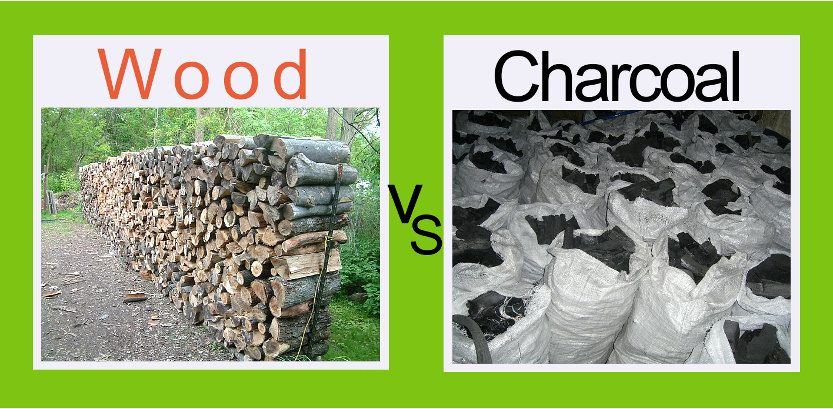
By Kobus Venter
Is it better to burn wood or charcoal? Half the World’s population of nearly six billion people prepare their food and heat their homes with coal and the traditional biomass fuels of dung, crop residues, wood and charcoal (Inheriting the world: The atlas of children’s health and the environment, by Bruce Gordon, Richard Mackay and Eva Rehfuess, WHO 2004). In China, India and Sub Saharan Africa, up to 80% of urban households use biomass fuels for cooking. Wood fuel usage is the most predominant with charcoal a close second. What is their respective influence on global warming? Sorry, but this post will not attempt to discuss this complex issue, because the reality is that for most people struggling with energy security, saving the environment is not exactly high on their list. The following paragraphs will instead focus briefly on the burning characteristics of wood and charcoal, because in many cases availability and affordability of the fuel type will dictate which fuel type is being used.
Typically wood has an energy value of between 14 and 18 MJ/kg when burned. Charcoal has an energy value of around 29 MJ/kg, in other words charcoal burns hotter than wood, but when not insulated or not receiving sufficient air supply (including secondary air), the absence of flames or fast flowing CO2 gases will result in less efficient cooking due to a lower heat transfer efficiency (HTE). In other words with conventional charcoal burning (glowing embers) the pot will receive radiant and infrared heat, with the pot positioned close to the coals. Wood burning flames (especially from open fires) tend to ‘lick’ the pot and transfer heat more effectively, but contain products of incomplete combustion (PIC), also known as ‘particulates’, that are harmful to humans when inhaled. In many instances households cannot afford to purchase or install chimneys that remove the smoke. The flames (yellow colored) will also tend to blacken cooking pots. Indoor smoke inhalation gives rise to pneumonia and other respiratory infections – the biggest killer of children under five years of age. Indoor air pollution (IAP) is responsible for nearly half of the more than 2 million deaths each year that are caused by acute respiratory infections (ARI). Good ventilation and improved cooking stoves can dramatically reduce children’s exposure to smoke. Vuthisa currently promotes the StoveTec stove which is very fuel efficient (conserves wood) and emits 70% less smoke. Visit http://vuthisa.com/news/stovetec for more information.
Charcoal is preferred over wood as a cooking fuel in many parts of the world because it does not produce smoke, is easier to transport and ready to use in a convenient dry- and broken-up form. Charcoal burning however produces large amounts of Carbon Monoxide (CO) which is harmful to humans when exposed to very high levels. Increasing air flow through the charcoal emits more CO, so if you don’t mix secondary air with the CO and insulate the fuelbed to raise temperatures to spontaneously combust that mix, you’re better off with a glowing ember burn. Most charcoal stoves (i.e. Ceramic Jiko) are not designed around this principle and won’t be much different to your barbecue, whereby you vent all the gases first and then cook on the glowing embers. There is anecdotal evidence that family members have succumbed to CO poisoning, but families using charcoal are very aware usually of it’s dangers and allow for adequate ventilation.  Why is CO harmful to humans? Let me explain: The effect of high levels of exposure to CO can be lethal, but even low levels of exposure can have harmful effects. CO diffuses rapidly via blood vessel membranes. Once it’s present in the bloodstream, CO binds to hemoglobin 200 times more readily than oxygen. This forms carboxy-hemoglobin (COHb). COHb reduces the oxygen carrying capacity of the blood and impairs the release of oxygen from hemoglobin. The neurobehavioral effects include impaired coordination, tracking, and driving ability. Cognitive performance is impaired at COHb levels as low as 5%. During exposure to a fixed concentration of CO, the COHb concentration increases rapidly at the onset of exposure. This levels off after about three hours, and reaches steady state after 6 – 8 hours of exposure. Headaches, nausea and loss of consciousness occur at COHb levels of 25-40%. Permanent brain damage and death follow if COHb levels exceed 45%. Vuthisa developed a safe charcoal stove over the last few years to address this very issue.
Why is CO harmful to humans? Let me explain: The effect of high levels of exposure to CO can be lethal, but even low levels of exposure can have harmful effects. CO diffuses rapidly via blood vessel membranes. Once it’s present in the bloodstream, CO binds to hemoglobin 200 times more readily than oxygen. This forms carboxy-hemoglobin (COHb). COHb reduces the oxygen carrying capacity of the blood and impairs the release of oxygen from hemoglobin. The neurobehavioral effects include impaired coordination, tracking, and driving ability. Cognitive performance is impaired at COHb levels as low as 5%. During exposure to a fixed concentration of CO, the COHb concentration increases rapidly at the onset of exposure. This levels off after about three hours, and reaches steady state after 6 – 8 hours of exposure. Headaches, nausea and loss of consciousness occur at COHb levels of 25-40%. Permanent brain damage and death follow if COHb levels exceed 45%. Vuthisa developed a safe charcoal stove over the last few years to address this very issue.
I don’t advocate charcoal usage over wood, because of the wasteful manner in which charcoal is made and the charcoal trade destroys naturally occurring forests and contributes to global warming. There are signs that governments are trying to regulate the industry by introducing more efficient charcoal-making kilns and establishing plantations to ensure sustainability of the timber source. In Namibia, millions of hectares of encroachment bush is being converted to charcoal and sold to neighboring South Africa as barbecue charcoal. South Africa itself (according to the most recent South Africa Yearbook) is plagued with alien plant infestations, totaling more than 10 million hectares, about eight percent (8%) of the country’s land surface area. The rate of spread is alarming and their numbers are projected to double over the next 15 years. More recently Vuthisa Technologies started to convert slashed invasives into charcoal and biochar using Emission Reducing Biochar kilns in a project known as the Vuthisa Biochar Initiative.
My verdict: It seems there is no clear winner, just spare a thought for the millions of people that rely on either wood or charcoal for their day to day survival.
